Key takeaways:
- Spiritual storytelling serves as a bridge between personal experiences and universal truths, fostering both individual growth and community connections.
- Religious texts offer moral guidance and shared wisdom, creating a sense of community among readers through collective exploration and discussion.
- The act of storytelling reveals hidden truths and fosters authenticity, allowing both the storyteller and the audience to connect on a deeper emotional level.
- Effective storytelling techniques include integrating personal anecdotes, using vivid imagery, and allowing pauses for reflection to enhance engagement and connection.

Understanding spiritual storytelling
Spiritual storytelling is a profound way to explore our inner selves and connect with the divine. I remember sitting around a campfire, captivated by an elder sharing a tale that blended personal experience with timeless truths. It made me wonder: how do the stories we tell shape our spiritual journeys?
At its core, spiritual storytelling transcends mere narrative; it’s a bridge between the tangible world and the unseen. I vividly recall the first time I read a spiritual fable that resonated deeply with my struggles. Each character’s challenge mirrored my own, prompting me to ask myself how I could apply those lessons to my life. Have you ever encountered a story that felt like it was written just for you?
Through the art of storytelling, we can explore complex concepts like forgiveness, love, and purpose in a relatable manner. When I reflect on my journey, I recognize that sharing my own experiences not only helped me heal but also created connections with others. What stories do you carry within you that could illuminate your path and inspire others along theirs?
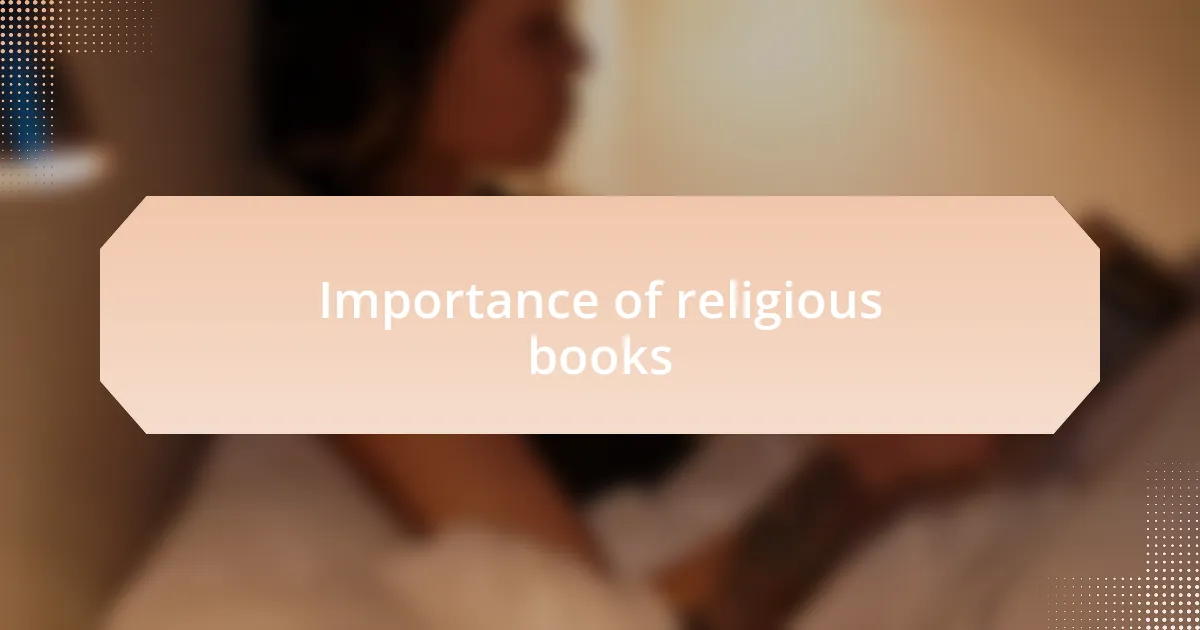
Importance of religious books
Religious books serve as a vital compass for the faithful, guiding individuals in their moral and ethical choices. I recall a time when I faced a significant life decision, and it was a passage from a religious text that offered clarity and direction. Have you ever experienced that moment when a line leaps off the page and feels like it was meant just for you?
These books are not only repositories of ancient wisdom but also mirrors reflecting our struggles and aspirations. I often find solace in their pages during moments of doubt—it’s as if the authors anticipated my questions long ago. Isn’t it fascinating how these texts continue to resonate through generations, bridging our personal quests with collective beliefs?
Additionally, religious books foster a sense of community among readers. In my own experiences, discussing these texts with friends has opened dialogues that deepen our understanding and bring us closer together. How do you think shared readings can transform relationships and enhance spiritual connections?
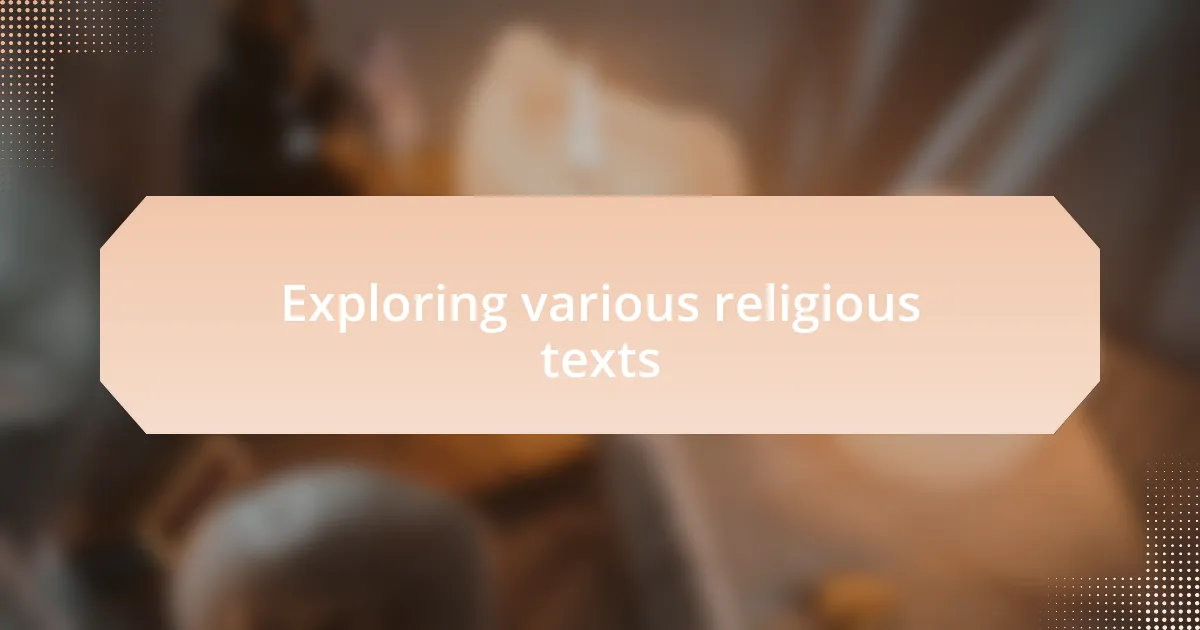
Exploring various religious texts
Venturing into various religious texts feels like embarking on a treasure hunt. Each one offers unique insights and cultural perspectives that can profoundly enrich our spiritual journeys. I remember the first time I read the Bhagavad Gita; its layers of meaning unfolded in surprising ways, prompting me to reevaluate my life choices. Have you ever uncovered wisdom that felt like a personal revelation?
Diving into the Quran was another eye-opening experience for me. The poetic nature of its verses captivated me, and I was struck by how the text encourages compassion and understanding. I often reflect on how these teachings resonate with today’s challenges, making me feel connected across time and space. Isn’t it incredible to think about how these messages are as relevant now as they were centuries ago?
Each encounter with religious texts reveals a shared humanity beneath diverse beliefs. I’ve participated in interfaith discussions where we explored different scriptures together. It’s remarkable how such gatherings foster empathy and dismantle preconceived notions, allowing me to appreciate the beauty in our differences. Have you ever participated in a similar exchange that broadened your understanding of faith?
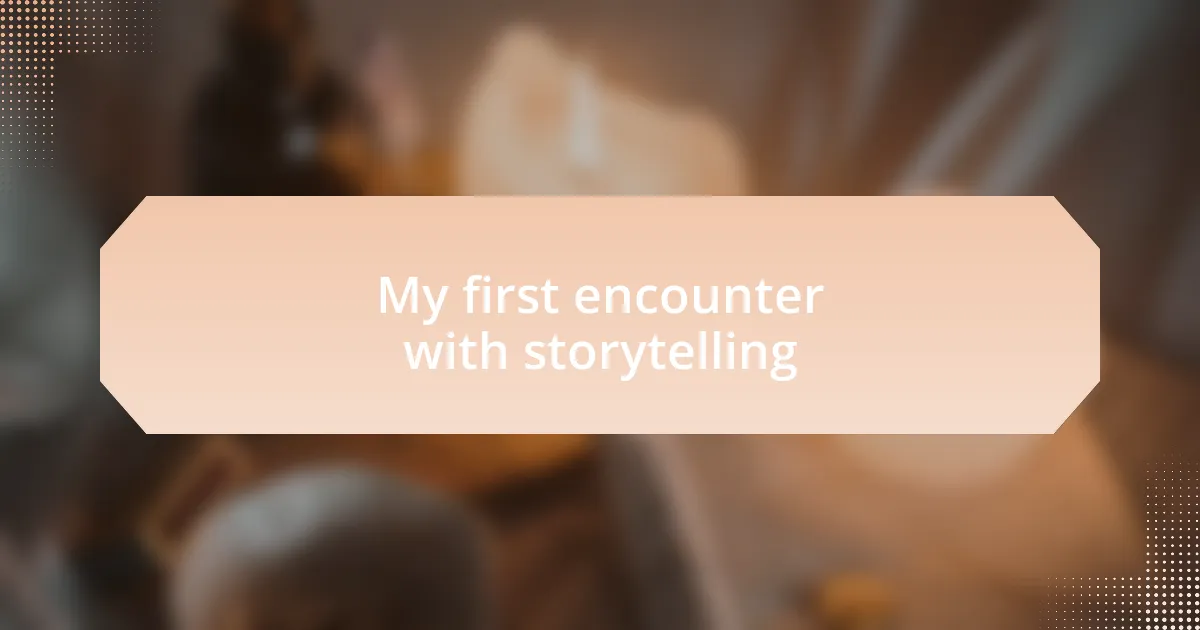
My first encounter with storytelling
I’ll never forget the moment I was first introduced to storytelling as a means of sharing wisdom. Sitting around the campfire with family, I listened to my grandmother weave tales from her own life, acknowledging the mistakes she made and the lessons learned. It struck me how these narratives carried the weight of experience and truth, sparking curiosity within me about the stories that shape our beliefs.
One evening, we gathered to hear an elder share parables from ancient traditions, and I was captivated by how each story held a moral lesson. The way he described the characters felt so vivid that I could picture their struggles and triumphs as if they were my own. Wasn’t that a fascinating way to connect with ideas that transcended time and culture? I realized storytelling wasn’t merely entertainment; it was a profound means of understanding the world.
As I began to explore my own narratives, I discovered that my experiences could also offer insights to others. I remember journaling about personal challenges and the clarity that came from articulating my thoughts in story form. Have you ever felt that rush of revelation while recounting your journey? It was at that moment I understood that storytelling could bridge personal and spiritual growth, allowing both the storyteller and the listener to embark on a shared journey of discovery.
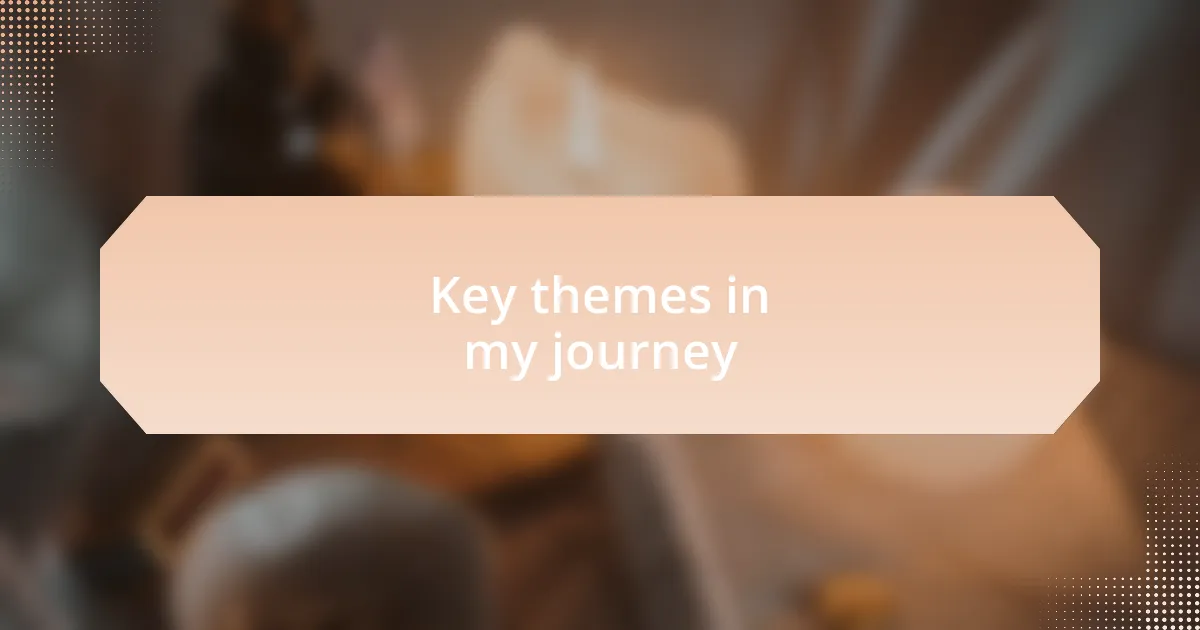
Key themes in my journey
In my journey through spiritual storytelling, a key theme emerged: the transformative power of vulnerability. I recall a time when I shared my struggles with fear in a small group. As I spoke, I felt a weight lift from my shoulders, and I noticed others nodding along, their eyes reflecting their own battles. Did you ever notice how sharing your fears can create an unbreakable connection?
Another theme that resonated with me is the significance of community. One evening, while narrating a story that intertwined my spiritual lessons, I encouraged my listeners to share their own experiences. The atmosphere shifted—what started as my story blossomed into a mosaic of shared wisdom and support. Isn’t it remarkable how such exchanges can redefine our understanding of our own narratives?
Lastly, the exploration of identity has been central to my journey. While recounting my experiences, I often found myself grappling with who I am and what I believe. I remember writing about a period of doubt, where my faith felt shaky and uncertain. Each story became a stepping stone toward self-discovery. Have you ever explored your identity through the stories you tell?
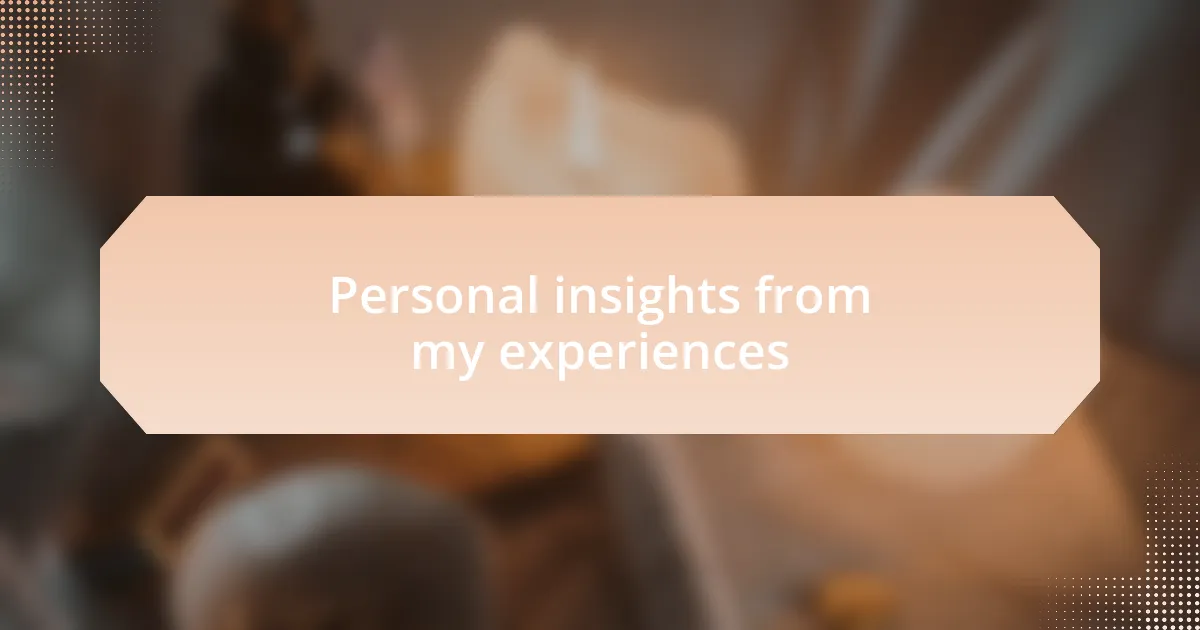
Personal insights from my experiences
Reflecting on my experiences, I’ve discovered that storytelling often unveils hidden truths within myself. During one storytelling session, I found a profound sense of clarity while discussing forgiveness. I shared a personal story of reconciliation with a family member, and as the words flowed out, I realized how much I had truly grown. Have you ever experienced that moment when speaking your truth reveals layers of personal growth you didn’t even know were there?
There was a specific time when I felt deeply connected to my audience while narrating a tale about hope amid despair. I could see tears in the audience’s eyes, mirroring my own once untouched pain. This connection made me realize that our stories have the power to heal, not just ourselves, but others too. Isn’t it fascinating how one narrative can resonate so deeply with another person’s experience?
I frequently contemplated the role of authenticity in storytelling. Once, during a workshop, I decided to share a story that exposed not only my vulnerability but also my fears of inadequacy as a story-weaver. To my surprise, the room fell silent, and then I felt an overwhelming wave of support wash over me. That moment struck me profoundly: when we allow ourselves to be authentic, we create a safe space for others to do the same. How often do we shy away from our genuine selves for fear of judgment?
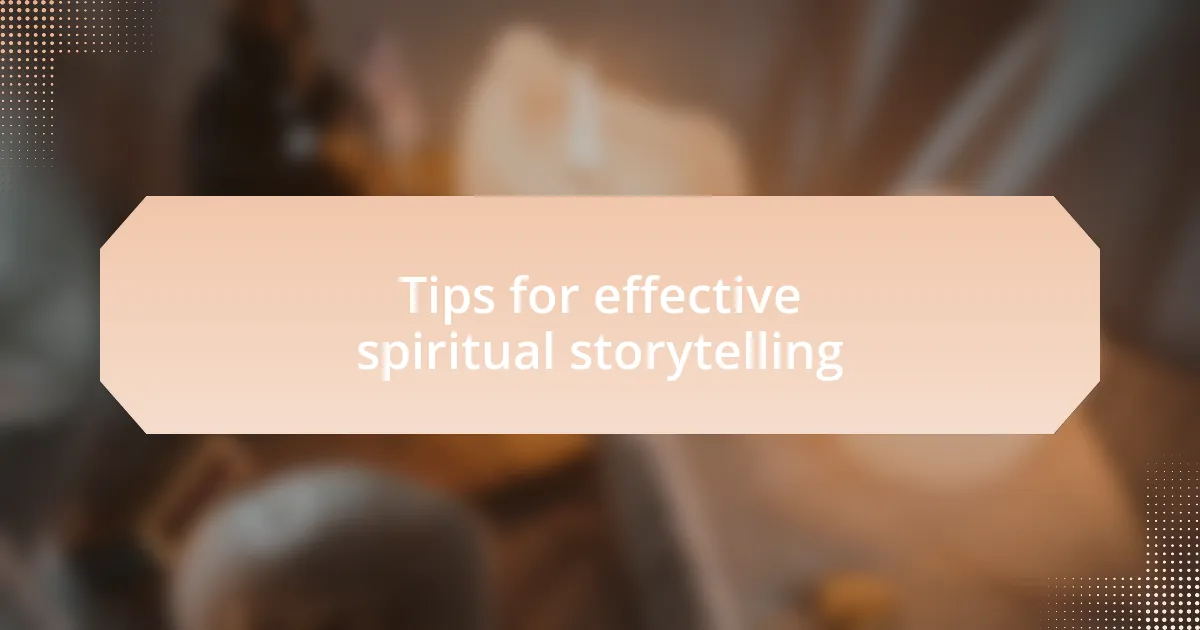
Tips for effective spiritual storytelling
When it comes to effective spiritual storytelling, one of the most powerful techniques I’ve found is to weave in personal anecdotes. I remember a particular instance when I told a story about a time I faced uncertainty and sought solace in prayer. As I described the emotional turmoil and eventual peace I found, I could see the audience’s expressions shift, as if they were reliving their own moments of doubt. Isn’t it interesting how sharing our vulnerabilities can forge an immediate connection?
Another vital tip is to focus on the imagery within your narrative. I once shared a story recalling my childhood visits to a serene forest and how the tranquil environment helped me find inner peace. By painting vivid pictures with my words, I noticed that listeners not only engaged with my journey but began to reflect on their own experiences, lost in their thoughts. How often do we forget that a well-crafted image can transport someone else to a different emotional state?
Lastly, never underestimate the importance of pausing for reflection during your storytelling. I learned this during a meditation retreat where a facilitator encouraged us to pause after sharing an experience. The silence that followed those moments allowed participants to absorb the story’s essence and connect it to their lives. Have you tried allowing space for reflection in your own storytelling? It can be a transformative practice that deepens the impact of your narrative.